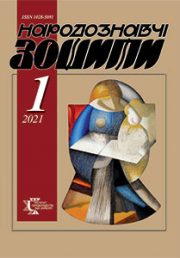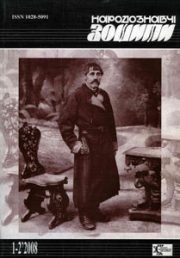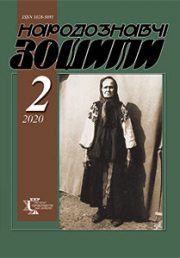The Ethnology Notebooks. 2020. № 5 (155), 1030—1036
UDK 94 (477) (092)
DOI https://doi.org/10.15407/nz2020.05.1030
«THE TERRIBLE ENEMY OF OUR PEOPLE»: EDUCATIONAL ISSUES AS HIGHLIGHTED ON THE PAGES OF «OUR LEMKO»
NAKONECHNYJ Volodymyr
- ORCID ID: https://orcid.org/0000-0002-0386-2162
- PhD (History), Assistant Professor, Department
- of International Relationships, Kyiv National
- University of Culture and Arts,
- 36, Yevhen Konovalets str., 01601, Kyiv, Ukraine,
- Contacts: e-mail: nakonechniy.ua@gmail.com
Abstract. For the first time in historiography, the article analyzes the cultural and educational policy of the «Our Lemko» editors, aimed at overcoming mass illiteracy in the Ruthenian environment.
The relevance of the article is defined by the need to clarify the peculiarities of the educational activities of Lemko figures in the context of anti-Ukrainian policies implemented by the governments of the Second Polish Republic.
The subject of the study is the peculiarities of the discussion of various cultural and educational issues on the pages of «Our Lemko».
The purpose of the study is to clarify the educational potential of various publications in the journal «Our Lemko».
The source of this historical research was a set of journals written by the censorship committee, which made it possible to review all the materials planned for publication, not just those left after meticulous censorship.
Methods. The article uses such methods and approaches as systematic, comparative and critical analysis of the source base, represented by large text arrays. The application of the content analysis technique made it possible to carry out the correct interpretation of newspaper information of various genres.
Conclusion. After analysing the materials of «Our Lemko», the author highlighted the multifaceted cultural and educational service of the editorial board of «Our Lemko». «OurLemko» paid the most attention to the formation of «Prosvita» reading rooms, as well as to the legal and methodological support of their activities. Thanks to this initiative, the network of «Prosvita» reading rooms in the Lemko region grew significantly during the second half of the 1930s. Another successful educational initiative was the celebration of certain months of the year as a time of mass reading, the struggle against moscophile ideology and its popularizers in the Ukrainian Carpathian mountains. The magazine’s editors explained that moscophiles were «werewolves» who tried to tear the Lemkos away from Ukrainians at all costs. Fighting moscophilia, «Our Lemko» has implemented several publishing projects aimed at strengthening the Ukrainian national consciousness in the Lemko environment. The texts were aimed at forming the national identity of Lemkos, which led to the strengthening of national self-awareness and public solidarity. We consider the conducted research as the first step to clarify a broader problem — the peculiarities of the cultural and educational work of Lemko institutions throughout the twentieth century.
Keywords: «Our Lemko», cultural and educational activities, the Second Commonwealth.
Received 3.10.2020
REFERENCES
- Nakonechnyi, V. (2019). Yuliian Tarnovych as a researcher of Polish-Ukrainian relationships. Problems of the humanities: a collection of scientific works of Drohobych Ivan Franko State Pedagogical University. History Series (Part 1/43, pp. 213—228). DOI: 10.24919/2312-2595.1/ 43.184280 [in Ukrainian].
- Denysiuk, V., & Krovytska, O. (Eds.). (2002). My native Lemko land, I will stay in your beauty. Lviv [in Ukrainian].
- Masley, A., & Pylypovych. V. (Eds.). (2004). Biweekly «Our Lemko» 1934—1939. Chosen publicist works. Gorlice: Zjednoczenie Lemkow [in Ukrainian].
- (1934). What «Our Lemko» is going to write about. Our Lemko, 1, 2 [in Ukrainian].
- (1934). To fight illiteracy! To all Citizens! Our Lemko, 23, 1 [in Ukrainian].
- (1934). Where to look for the light of truth and science? Our Lemko, 6, 2—3 [in Ukrainian].
- (1934). Why we need to read the books? Our Lemko, 3, 2 [in Ukrainian].
- (1934). Our reading room is working. Our Lemko, 9, 2 [in Ukrainian].
- Berezіvs’kiy, K. (1938). Why our every home should be a reading hall? Our Lemko, 3, 2—3 [in Ukrainian].
- (1934). How to spend winter evenings? Our Lemko, 24, 5 [in Ukrainian].
- (1934). Citizens! Our Lemko, 23, 3 [in Ukrainian].
- (1934). Lemko youth. We create our own life! Our Lemko, 10, 2 [in Ukrainian].
- (1934). «Our Lemko» in every Lemko house! What should be the educators of Lemkivshchyna? Our Lemko, 17, 4 [in Ukrainian].
- (1934). Rymanivshchyna on the front of cultural and educational work. Our Lemko, 11, 1 [in Ukrainian].
- (1935). Education in Argentina. Our Lemko, 2, 2 [in Ukrainian].
- Tarnovych,Yu. (1934). Where is our salvation. Our Lemko, 23, 2 [in Ukrainian].
- (1934). We will fight against the darkness and trouble! Our Lemko, 13, 2 [in Ukrainian].
- (1934). Village Ropytsia, powiat Golytsia. Our Lemko, 8, 8 [in Ukrainian].
- (1934). How are the readers Kachkovsky in Lemkivshchyna? Our Lemko, 6, 2 [in Ukrainian].
- Gist‘. (1934). Radoshyci near Komanchi. Our Lemko, 9, 7 [in Ukrainian].
- (1934). History of the «Lemko primer». Our Lemko, 18, 4 [in Ukrainian].
- (1934). «We do not want the ABCs». Our Lemko, 20, 3 [in Ukrainian].
- (1934). Lemko‘s primer. Our Lemko, 8, 5 [in Ukrainian].
- (1934). Take care of your native language! Our Lemko, 13, 3 [in Ukrainian].
- Telvak, V. (2008). Creative heritage of Mykhailo Hrushevsky in the estimations of his contemporaries (the end of the 19th and the 30th years of the 20th century). Kyiv; Drohobych [in Ukrainian].







